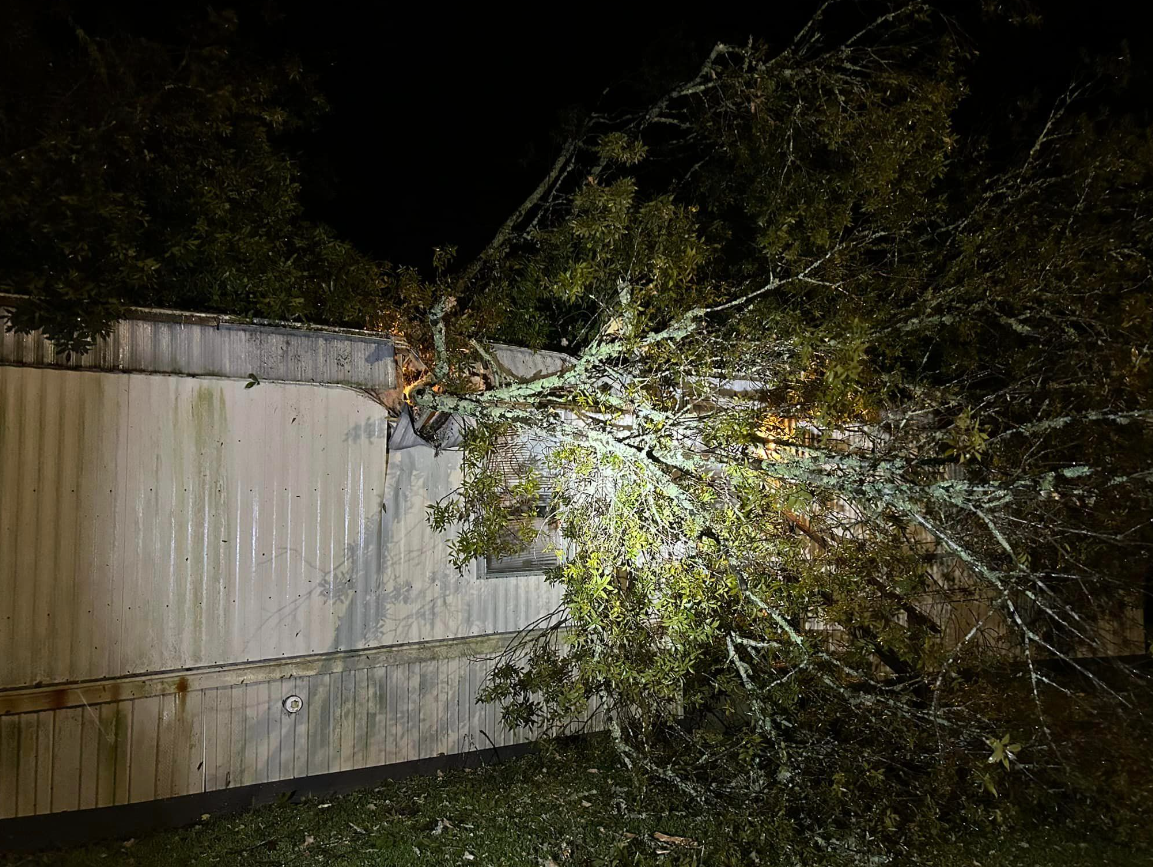Emerald Mound is a site I’ve been fortunate to visit many times. My father, Justin Hogue, has a deep appreciation for the natural world and a profound respect for the Native cultures of Mississippi. As a child, I recall our “adventure days,” where my parents would load us into the car, and my brother and I would take turns choosing which roads to explore, always with an unknown destination. Sometimes I picked a street because its name was appealing, other times I followed a color I saw. More often than not, our travels led us to the Natchez Trace, where we would stop at historic sites along the way. These adventure days likely sparked my passion for history.
I vividly remember my first visit to Emerald Mound. After an hour or two of driving, with my brother and me debating the next turn, my dad finally stopped at Milepost 10.3. We all climbed out of the car and were greeted by a lush, green landscape, with the early signs of fall appearing in the trees. My brother and I raced to the base of a hill, and the word that instantly came to my young mind was “massive.” This was no ordinary hill—it was the Emerald Mound.
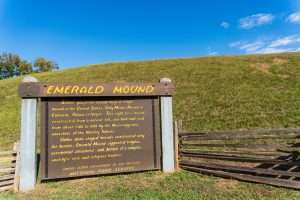
Just outside Natchez, Mississippi, stands Emerald Mound, the largest mound in the state and the second-largest Mississippian mound in the United States. Constructed and utilized between approximately 1200 CE and 1730 CE, this monumental earthen structure rises 37 feet high and covers nearly 8 acres. Its impressive tiered design includes two smaller mounds situated atop the main mound, which brings its total height to about 60 feet. Historical records indicate that there were once six additional smaller mounds around the primary mound, though these have since disappeared (NPS). So, what is the significance of this enormous site, and who were the people who built it?
Construction and Context
To understand Emerald Mound’s significance, it’s helpful to review the broader context of mound-building across different prehistoric periods. During the Paleo-Indian period (circa 12,000 BCE to 8,000 BCE), the inhabitants of Mississippi were nomadic hunter-gatherers, focusing on following large game like mastodons and woolly mammoths (StoryMaps, 2024). Archaeological sites from this era primarily consist of stone tools and hunting evidence, with little indication of permanent settlements.
In the subsequent Archaic period (circa 8,000 BCE to 1,000 BCE), there was a shift toward more settled living. People established temporary camps and semi-permanent settlements, often in caves or on elevated land near rivers (StoryMaps, 2024). This period saw the development of simple housing structures and a diverse subsistence strategy that included small game, fish, and plant resources (StoryMaps, 2024).
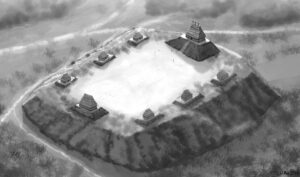
The Woodland period (circa 1,000 BCE to 1,000 CE) marked a significant evolution in mound construction. This era introduced the creation of complex burial mounds and ceremonial structures, reflecting advancements in social organization and spiritual practices (Mississippi Encyclopedia, n.d.).
Transitioning into the Mississippian period (circa 800 CE to 1600 CE), Mississippi experienced the rise of highly organized societies. The Mississippian culture is known for its large, sophisticated mound complexes, such as Cahokia Mounds in Illinois and Emerald Mound in Mississippi (NPS, n.d.). Unlike earlier periods, the Mississippian era featured extensive platform mounds and ceremonial centers, highlighting advanced social and political organization (NPS, n.d.).
Emerald Mound’s Unique Features
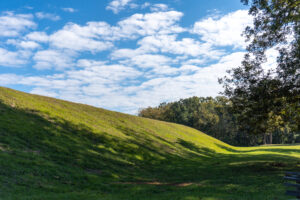
Emerald Mound exemplifies Mississippian mound-building and societal complexity. Covering approximately 8 acres and rising 35 feet high, with an additional height from two smaller mounds, it stands out as one of the largest platform mounds in the southeastern United States (Explore Southern History, n.d.). The mound’s multi-tiered structure and broad, flat top suggest it was used for significant ceremonial or political purposes (NPS, n.d.). This design reflects the Mississippian society’s ability to mobilize resources and labor on a grand scale (NPS, n.d.).
The construction of the Emerald Mound involved a massive effort, with builders likely using baskets to transport soil, which was then deposited and compacted to form the mound (NPS, n.d.). This labor-intensive process required considerable time and coordination, illustrating the organized nature of Mississippian society (NPS, n.d.).
Historical Encounters and Archaeological Discoveries

During Hernando de Soto’s exploration of the southeastern United States in the 1540s, Mississippian culture was still flourishing, with ceremonial mounds like Emerald Mound in active use (StoryMaps, 2024). Spanish accounts from this period describe the mounds being used for various activities, reflecting their ongoing importance (Explore Southern History, n.d.). By the early 1700s, French explorers observed that the Natchez and other local cultures continued to uphold traditional Mississippian customs (StoryMaps, 2024). However, many Mississippian sites had been abandoned by the late 1600s due to European diseases, colonial pressures, and internal conflicts (StoryMaps, 2024).
Archaeological investigations at Emerald Mound began in 1838 and continued intermittently until 1972. These studies have provided valuable insights into the mound’s construction and the people who built it (NPS, n.d.). Restoration efforts have included stabilizing the mound’s surface to prevent erosion. Emerald Mound was designated a National Historic Landmark in 1989 and transferred to the National Park Service in 1950 (NPS, n.d.).
Mississippian Culture and Adaptation
The Mississippians, who constructed Emerald Mound, were part of a broad cultural network in the Mississippi Valley and southeastern United States before European contact (StoryMaps, 2024). They practiced advanced agriculture, cultivating crops like corn, beans, and squash, alongside hunting and fishing (Mississippi Encyclopedia, n.d.). Their communities, featuring both dense village centers and surrounding hamlets, were organized to undertake large-scale projects like mound construction (StoryMaps, 2024). Extensive trade networks brought goods such as shells from the Gulf of Mexico and copper from near Lake Superior (StoryMaps, 2024). Despite disruptions, including internal and external conflicts, Mississippian traditions continued among contemporary Southeastern tribes, including the Chickasaw and Choctaw (NPS, n.d.).
Social and Ceremonial Functions
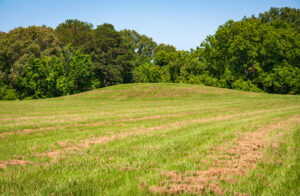
Mississippian mounds, including the Emerald Mound, served various purposes, such as burial sites, temples, and ceremonial centers (Explore Southern History, n.d.). Emerald Mound functioned as a central hub for ceremonial activities, with a nearby village site later destroyed by cultivation (Natchez Belle, n.d.). The mounds were used for events, dances, and religious rituals, reflecting the complex social and spiritual life of the Mississippians (NPS, n.d.). Ongoing archaeological research continues to shed light on the site’s historical significance and the lives of its early inhabitants (StoryMaps, 2024).
What does this mean?
As European explorers arrived and disruptions such as diseases and colonial pressures took their toll, many Mississippian sites, including the Emerald Mound, were abandoned. However, the cultural legacy of the Mississippians persisted and influenced modern Southeastern tribes like the Chickasaw and Choctaw.
Today, the Emerald Mound is more than an archaeological site; it is a symbol of the Mississippian people’s achievements and a crucial link to their heritage. Its preservation and study help connect contemporary communities with their ancestral past and continue to inspire an appreciation of the rich cultural history of the Southeast.
Plan Your Adventure Day Now!

The best part of Emerald Mound? It’s open to the public.
Pack up you and your family, or travel alone on an adventure day and see for yourself. An established trail of allows you to walk to Emerald Mound and feel the history. Here at Milepost 10.3, you can marvel at the sheer size of the mound and you can’t help but have an appreciation of those who made Emerald Mound their lives. Get directions here.








